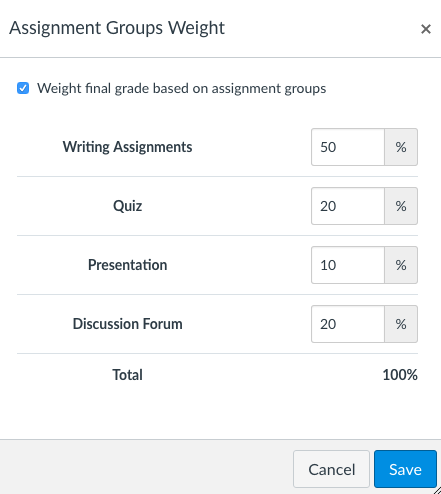Body
This guide provides an overview of how grading works in Canvas. Specific how-to information on the sections below can be found in the Canvas Instructor Guide. If you are using Canvas to distribute grades to students throughout the semester, read through each section carefully to ensure that you are using the gradebook appropriately. If anything is unclear or confusing, please contact Technical Support Services at 610-660-2920 or submit a service request at https://www.sju.edu/help.
- Assignments = Gradebook Columns.
You add columns to the gradebook by adding assignments. For columns that do not have a corresponding assignment submission, leave the assignment set to “No submission."
See: Canvas Video Guide: Assignments Overview
- All assignments should eventually have a grade.
The New Gradebook treats Ungraded as O. Any graded assignments should have a great. Otherwise, their total grade will be lower than it should be.
- All required assignments must specify the total points possible.
This is done in the assignment settings and is needed for Canvas to accurately determine the total points possible for the course and, therefore, calculate an accurate total percentage. Carefully check the "Total" score column in the gradebook to make sure grades are what they should be.
- Unique calculation scenarios are managed in Assignments.
Create assignment groups with grading rules to drop the lowest or highest n scores. Check the “Weight the final score” box to set up weighting by assignment group.
See Assignments section below.
- For letter grades, set up a grading scheme.
Go to the Settings tab in the left-hand course navigation. Select the Course Details tab. Click "Edit Course Details" and check off “Enable Course Grading Scheme” followed by “Set Course Grading Scheme.” Make sure to set the grading scheme to Emerson College.
See Using Letter Grades section below.
- Assignment Grades and Total column are visible to students by default.
You can mute individual assignment grades and hide the Total column if you’re not ready to display grades. Hiding the Total column is recommended if you are not using Canvas to calculate final grades, since students may be seeing a Total grade that is inaccurate.
See: How do I hide totals in my students' grade summaries? and How do I mute an assignment in the Gradebook? in the Canvas Instructor Guide.
How Canvas Calculates Total Grades
By default, Canvas will calculate total grades using the Standard Grading Formula described below for all graded assignments. If you organize your assignments into assignment groups and you weight those assignment groups, Canvas will calculate total grades using the Weighted Grading Approach described below.
Standard Grading Formula
(Points Earned / Total Points Possible)*100 = Total Score (as percentage)
Weighted Grading Approach:
If you are using a weighted approach, each assignment group will follow the standard formula: (points earned for the assignment group/total point possible for the assignment group)*100. Each assignment group score is then converted to a percentage of the total grade based on the weight that you’ve given it. For example, the below assignment group, “Book Reports”, is worth 25% of the final grade:

If a student scored 100 points for each of the 3 assignments, their score for the group would be 100%. So, they would get 25 points towards the final grade for this assignment group: [(300/300)*100]*.25=25
Assignments
The Assignments tab is arguably the most central to the Canvas Gradebook:
- It controls the columns in the gradebook and gradebook calculations.
- It displays all things gradable, including assignments, graded discussions, and graded quizzes.
See: Canvas Video Guide: Assignments Overview
Use assignment groups to:
- Group assignments
- Add the grading rules:
- Drop the lowest score(s) in a group
- Drop the highest score(s) in a group
- Never drop x assignment
- Weight grades
Weighting Assignment Groups
- Click on the
 icon on the upper right of the Assignments page, then click on "Assignment Group Weight".
icon on the upper right of the Assignments page, then click on "Assignment Group Weight".
- Check the box for "Weight final grade based on assignment groups".
- Enter the weight for each assignment group in the form on the right. (Weights should typically equal 100, but can exceed 100 for extra credit)

Using Letter Grades
If you are using letter grades for your assignments and want Canvas to calculate grades for you, you need to enable a grading scheme. Make sure you choose the Emerson College grading scheme since the default grading scheme is slightly different.
See: Canvas Instructor Guide: How do I enable a grading scheme for my course?
If you don’t need Canvas to calculate grades for you, you still need to make sure assignments are set to “Grading By: Letter Grade.” If you don’t do this, the system will not accept a letter grade, only numbers.
See: Canvas Instructor Guide: How do I edit assignment details?
Common Mistakes When Setting Up Assignments and Grading
- Failing to change an assignment type from its default “No Submission” format:
Results in students not being able to submit their assignments online.
- Failing to specify the total points possible when setting up a required assignment:
Results in assignment functioning as extra credit.
- Failing to assign students who have not turned in an assignment a zero once the assignment due date has passed:
Results in students seeing a better grade than they are actually receiving.
- Failing to set and/or edit a custom grading scheme:
Results in no letter-‐grade calculation or an inaccurate letter-grade calculation
Credit: This guide is based on the Canvas Grading Handouts developed by Neal Legler for the Best Practices Webinar on Canvas Gradebook.